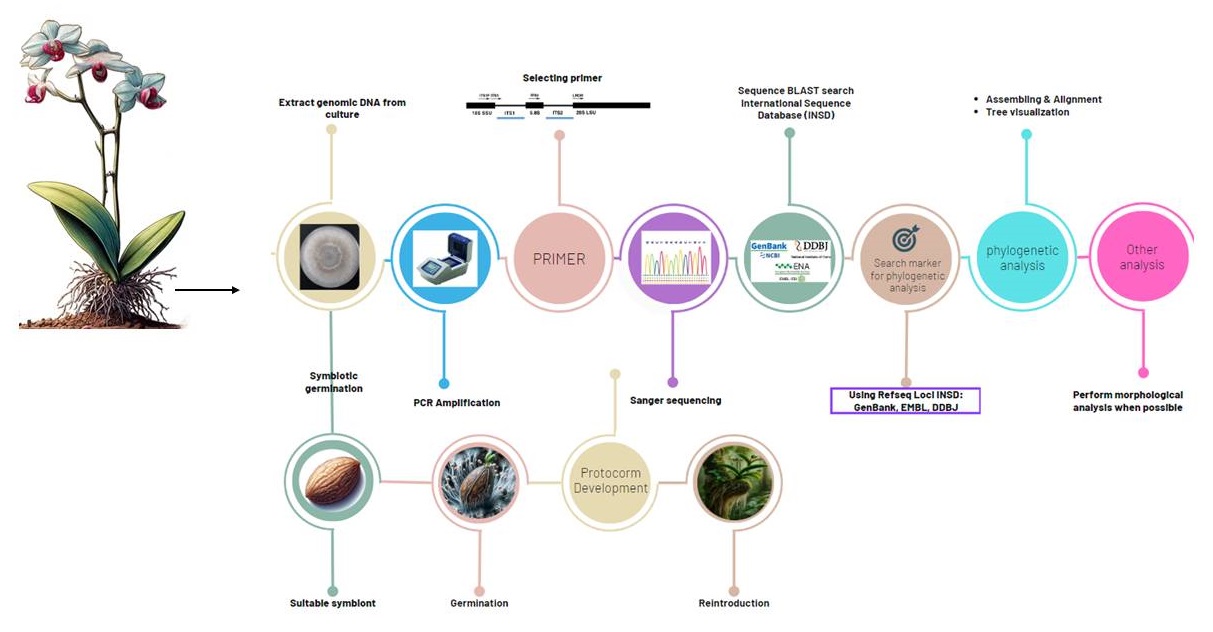
Published 2024-04-04
Keywords
- Orchid,
- Mycorrhizal fungi,
- identification
How to Cite
Copyright (c) 2023 Nor Amirah Shamsudin, Dr. Nor Azizun, Prof. Madya Dr Jualang, Prof. madya. DR Jaya Seelan

This work is licensed under a Creative Commons Attribution 4.0 International License.
Funding data
-
Ministry of Higher Education, Malaysia
Grant numbers FRGS/1/2021/WAB11/UMS/02/3 -
Universiti Malaysia Sabah
Grant numbers UMS GREAT GUG0059-1/2023
Abstract
Orchids are a diverse and widespread family of flowering plants, with over 25,000 known species and more than 100,000 hybrids and cultivars. Orchids are characterised by their often showy and highly specialised flowers and have unique and intricate floral. Orchids are known to be highly dependent on their mycorrhizal fungi for nutrient uptake, especially during the early stages of their development. Orchid seeds lack the endosperm present in most other seeds, which means they cannot germinate without a source of nutrition. The relationship between orchids and mycorrhiza is known as orchid mycorrhizae or orchid mycorrhiza. In orchid mycorrhiza, the orchid plant forms a mutualistic relationship with certain species of fungi that are able to penetrate the orchid’s roots and colonise its tissues to provides the orchid with essential nutrients. Orchid mycorrhizal fungi are often highly specific, meaning that they can only form partnerships with certain orchid species, and vice versa. The importance of mycorrhizal fungi in the orchid life cycle is crucial from both evolutionary and ecological standpoints. Therefore, it is essential to acquire a thorough comprehension of this relationship and develop methodologies for isolating, identifying, and preserving significant fungal strains that are associated with different orchid species. In recent years, there has been a considerable increase in research concentration on mycorrhizal interactions in orchids. However, certain inquiries remain unresolved pertaining to the fungal communities associated with orchids as well as the divergences notices across different species and geographical locales. The present paper provides a through, and extensive analysis of the fungal life associated with orchids. This article presents a succinct overview of the molecular techniques utilised by researchers globally to isolate and identify peloton-forming fungi in both temperate terrestrial and tropical orchids. The review begins by proving a concise introduction to the background material regarding the wide range of fungal species that are linked with orchids. It then proceeds to explores the topic of orchid mycorrhizal fungi (OMF) and orchid non-mycorrhizal fungi (ONF). The subsequent analysis explores the crucial function that orchid mycorrhizal fungi play in the processes of seed germination and development. Moreover, the study elaborates on the methodologies utilised for isolating fungi, extracting fungal DNA, selecting primers, amplifying DNA and subsequent analysis sequence data. This article considers several molecular identification approaches that are used in studying orchid endophytic mycorrhizal. Using molecular approaches, orchid mycorrhizal can be further explored and identified.




